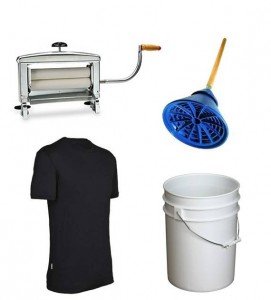Approaching a Steady State Economy, Part 2 — Clean Clothes
by Rob Dietz
To get a sense of how the broader economy works, it’s useful to analyze one particular sector. In trying to answer the question of how a non-growing economy could work, Part 1 of this article considered methods (categorized as “economizing” and “innovating”) for achieving a sustainable transportation sector. But the transportation sector is complex enough that it’s worth drilling down even further and analyzing something simpler. “Economy” derives from two Greek words that translate into “management of the household.” Thinking of the economy as a big household is a useful frame. Likewise, thinking of an actual household as a small economy can be a helpful exercise. I have made or been a party to many decisions in an attempt to run my household as a steady state. For example, my wife and I decided to have a one-child family. We also decided to live in a cohousing community founded on sustainability values. In the spirit of drilling down to the smallest scale possible, I want to describe my recent experiment with one “sector” of my household economy: the laundry.
For years I did laundry American style, fighting dirty clothes in a full-on assault with an army of water, detergent, heat, and electricity. I would:
- Dump my clothes in a pile after wearing them once;
- Use a water-hogging top-loader washing machine;
- Select the hot water setting because — well, because why not?; and
- Apply the hottest setting in an electric tumble dryer, including a dryer sheet or two.
As I learned more about conservation over time, I began to shift my laundry habits, by both economizing and innovating. For example, my family began using a front-loading machine that conserves water and electricity. I started sorting my laundry, hanging articles of clothing that were suitable for a second wearing. We began using only cold water for washing with no adverse results. We forgot about dryer sheets (no need to smell like a chemist’s over-scented interpretation of “spring fresh”), and then we forgot about the dryer entirely.
The electric tumble dryer is one of the most energy intensive home appliances, but it’s also one of the most unnecessary. As a friend of mine is fond of saying, “Clothes want to get dry all by themselves. You just leave them alone, and that’s what they do naturally.” Line drying clothes, then, is a simple way to cut energy usage. The folks at Project Laundry List see line drying as something even more powerful — an entryway to the world of sustainable behavior.
In my household, making the switch to line drying turned out to be fairly easy, so I decided to try another step. I wanted to see if I could have a low-water, resource-conserving, electricity-free laundry system that would get my clothes clean. My method is another mix of economizing and innovating.
The setup consists of four pieces of equipment: a five-gallon bucket, a portable clothes agitator that looks like a plunger, a hand-cranked wringer, and a clothesline. The procedure is simple:
- Put a little soap in the bucket and add a couple of gallons of water;
- Throw in five or six articles of dirty clothing;
- Plunge the agitator up and down in the bucket to force water, soap, and air through the clothes for a few minutes;
- Dump the water on the plants in the backyard and refill the bucket with two more gallons, adding the soapy clothes to rinse;
- Run each article of clothing through the wringer; and
- Hang the clothes on a line.

A simple laundry setup in which the wool shirt is the most high-tech item.
On the economizing front, the wringer, clothesline, and bucket are old-school technologies that draw energy from only the sun and a bit of personal labor. And there’s much less embedded energy in these tools than in a washer/dryer combo. A note about the labor: I thought it would be a more of a chore, but so far it’s been fun. There’s a degree of mindfulness that comes with washing clothes this way, and it doesn’t take very long. Granted, I’ve been conducting the experiment during the summer when I’m mostly wearing shorts and t-shirts, and the strong Pacific Northwest sun is accelerating the drying sessions.
On the innovating front, the agitator could be considered a new technology, but it’s such a simple device that it’s hard to think of it as being all that innovative. Where technology does come into play is in the clothing itself. This laundry method works much better with quick-drying clothes. I have been experimenting with natural wool clothes. Designers have figured out how to make quick-drying wool garments that are comfortable against the skin and don’t get stinky (as opposed to polypropylene and other synthetic materials). Such clothing can be pricey, but if you’re doing small loads of laundry each day or every other day, you don’t need to own very many of them — another nod toward economizing.
It’s still in flux, but I’ve gotten a good start on changing my behavior in the laundry sector of my household economy, and the change represents progress toward a steady state. Such changes are inconsequential in a numerical sense. My laundry process isn’t going to stabilize the climate or solve the global overshoot problem, but it’s a small step in the right direction. In addition to lowering my ecological footprint, this laundry experiment is helping me understand how the broader economy can economize and innovate to clean up its act.
 Rob Dietz brings a fresh perspective to the discussion of economics and environmental sustainability. His diverse background in economics, environmental science and engineering, and conservation biology (plus his work in the public, private, and nonprofit sectors) has given him an unusual ability to connect the dots when it comes to the topic of sustainability. Rob is the author, with Dan O’Neill, of Enough Is Enough: Building a Sustainable Economy in a World of Finite Resources.
Rob Dietz brings a fresh perspective to the discussion of economics and environmental sustainability. His diverse background in economics, environmental science and engineering, and conservation biology (plus his work in the public, private, and nonprofit sectors) has given him an unusual ability to connect the dots when it comes to the topic of sustainability. Rob is the author, with Dan O’Neill, of Enough Is Enough: Building a Sustainable Economy in a World of Finite Resources.






Thanks for the mention! Inside that steady state is a lot of self produced consumption. Least is best.
Enjoyed reading your article re laundry. I haven’t used a clothes dryer for probably 30 years and have not missed it once. Even when living in both Ohio and Michigan I just strung up some line in the basement and hung the clothes to dry, yes it may have taken one extra day not a problem for me.
I live in a senior community where most residents have never heard of the word conservation. They love their driers and their lights and their big autos so it’s up to the younger community to save what is left of this planet if my grandkids and your child have any hope for a decent future.
You will find that your clothes drying method will be much more difficult once the cold weather sets in, yet take heart in the fact that your whites will appear all the brighter, lol.
Hi Rob,
Where did you purchase your clothes washing items?
Regards,
Tim
Hi Tim,
I scrounged the bucket and lines. I couldn’t get the agitator and wringer locally, so I ordered them here:
http://www.getpreparedstuff.com/
The wool shirt is from Icebreaker (got it at a warehouse sale that was going on when I was in Portland).
Hope that helps,
Rob
I salute you for going beyond the machine for your laundry. Few will venture there, and for many it is an overwhelming amount of work (larger family, poor water, inappropriate climate, etc.). And, yes, icebreaker and similar ‘new wool’ are odour free, long wearing and quick drying.
For another perspective of ‘the laundry issue’ see the global impact in http://www.gapminder.org/videos/hans-rosling-and-the-magic-washing-machine/
What has been described in this article is just plain,ordinary thrift. Note that I didn’t say common. In much of Western society thrift is either unknown or is a dirty word.
Just as in conventional (as in dysfunctional) economics where it is fashionable to equate household with sovereign nation so equating steady state economics with household thrift is not doing any service for CASSE.
While I wholeheartedly support a steady state economy I couldn’t care less about how Rob does his laundry.
Rob,
Use a longer handle on your plunger/agitator instead of the one that it came with. Examples would be a broom/mop handle or a long handle for paint rolling a ceiling. It’ll be easier on your back.
RV’ers have long used an easy method. Using a plastic 5 gal bucket with lid… fill half way with water and appropriate amount of detergent, add clothes. Cover tightly, put in (RV), back of car or truck. The motion of the auto/RV agitates much like a washing machine. A half hour trip is good for most things. Heavy, ground in dirt will take longer.
This sounds really nice, but… doesn’t the soap in the wash bucket hurt the plants in your backyard? I don’t know a whole lot about gardening but I don’t think soap is particularly good for plants.
I am sorry that someone here doesn’t care about Rob’s method of washing clothes. It DOES matter, since EVERY piece of our lives adds up to the total impact.
I have NEVER owned a drier, nor have my parents. Folding clothes racks are especially good for the winter months when indoor humidity goes down to problematic levels causing nosebleeds and respiratory stress. An auto-off timer on my water heater saves energy too. Another relief from furnace-induced dryness is more moderate use of heating systems, and the use of more clothing to keep warm inside. A colder bathroom is quickly heated by a warm shower, if you let the water remain in the tub for several minutes. The added humidity is welcome as well.
It is NOT unusual to find multiple synergisms from more mindful living, nor is it unusual to find multiple negative impacts from blindly following the habits handed to us by the consumer culture. Using your noggin is often the best use of energy that one can choose for that day. It is almost NEVER a waste of time.